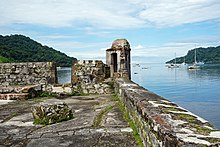
The War of Jenkins' Ear was a conflict lasting from 1739 to 1748 between Britain and Spain. The majority of the fighting took place in New Granada and the Caribbean Sea, with major operations largely ended by 1742. It was related to the 1740 to 1748 War of the Austrian Succession. The name was coined in 1858 by British historian Thomas Carlyle, and refers to Robert Jenkins, captain of the British brig Rebecca, whose ear was allegedly severed by Spanish coast guards while searching his ship for contraband in April 1731.

Admiral of the Blue Edward Boscawen, PC was a British admiral in the Royal Navy and Member of Parliament for the borough of Truro, Cornwall, England. He is known principally for his various naval commands during the 18th century and the engagements that he won, including the siege of Louisburg in 1758 and Battle of Lagos in 1759. He is also remembered as the officer who signed the warrant authorising the execution of Admiral John Byng in 1757, for failing to engage the enemy at the Battle of Minorca (1756). In his political role, he served as a Member of Parliament for Truro from 1742 until his death although due to almost constant naval employment he seems not to have been particularly active. He also served as one of the Lords Commissioners of the Admiralty on the Board of Admiralty from 1751 and as a member of the Privy Council from 1758 until his death in 1761.

Admiral Edward Vernon was a Royal Navy officer and politician. He had a long and distinguished career, rising to the rank of admiral after 46 years service. As a vice admiral during the War of Jenkins' Ear, in 1739 he was responsible for the capture of Portobelo, Panama, seen as expunging the failure of Admiral Hosier there in a previous conflict. However, his amphibious operation against the Spanish port of Cartagena de Indias was a disastrous defeat. Vernon also served as a Member of Parliament (MP) on three occasions and was outspoken on naval matters in Parliament, making him a controversial figure.

Portobelo is a historic port and corregimiento in Portobelo District, Colón Province, Panama. Located on the northern part of the Isthmus of Panama, it is 32 km (20 mi) northeast of the modern port of Colón now at the Atlantic entrance to the Panama Canal. It has a population of 4,559 as of 2010, and functions as the seat of Portobelo District.

Admiral Blas de Lezo y Olavarrieta was a Spanish navy officer best remembered for the Battle of Cartagena de Indias (1741) in the Viceroyalty of New Granada, where Spanish imperial forces under his command decisively defeated a large British invasion fleet under Admiral Edward Vernon.

Sebastián de Eslava y Lazaga was a Spanish general and colonial official. From April 24, 1740 to November 6, 1749 he was viceroy of the newly reestablished Viceroyalty of New Granada. He was governing the viceregal at the time of the defeat of British Admiral Edward Vernon at the Battle of Cartagena de Indias. After his death he was named marqués de la Real Defensa de Cartagena de Indias.

The Battle of Cartagena de Indias took place during the 1739 to 1748 War of Jenkins' Ear between Spain and Great Britain. The result of long-standing commercial tensions, the war was primarily fought in the Caribbean; the British tried to capture key Spanish ports in the region, including Porto Bello and Chagres in Panama, Havana, and Cartagena de Indias in present-day Colombia.
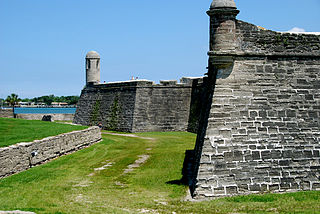
The siege of St. Augustine was a military engagement that took place during June–July 1740. It involved a British attack on the city of St. Augustine in Spanish Florida and was a part of the much larger conflict known as the War of Jenkins' Ear.
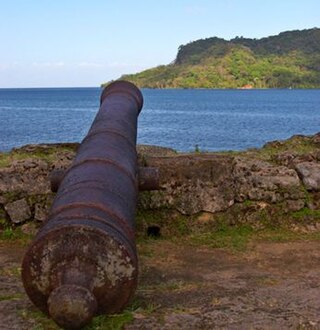
The Blockade of Porto Bello was a failed British naval action against the Spanish port of Porto Bello in present-day Panama between 1726 and 1727 as part of the Anglo-Spanish War. The British were attempting to blockade the port to stop the Spanish treasure fleet leaving for Spain with its valuable cargo. However tropical disease took its toll of the seamen to the extent that the British had to leave to re-crew, during which time the Spanish were able to re-commence shipping operations.
Vice Admiral Francis Hosier (1673–1727) was a British naval officer. He was a lieutenant on Rooke's flagship at the Battle of Barfleur in 1693. He captured the Heureux off Cape Clear in 1710 and distinguished himself in action with the Spanish off Cartagena in 1711. He is chiefly remembered, however, for his role in the failure of the Blockade of Porto Bello, for which poor Government orders were largely responsible, during which he died of disease alongside thousands of his sailors.

HMS Burford was a 70-gun third rate ship of the line of the Royal Navy, built at Deptford Dockyard to the 1719 Establishment, and launched on 19 July 1722. Burford was notably the early posting of both John Forbes and John Byng, both of whom rose to become Admirals.
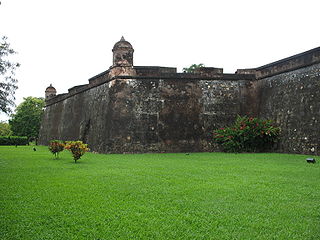
The Battle of San Fernando de Omoa was a short siege and battle between British and Spanish forces fought not long after Spain entered the American Revolutionary War on the American side. On the 16 October 1779, following a brief attempt at siege, a force of 150 British soldiers and seamen assaulted and captured the fortifications at San Fernando de Omoa in the Captaincy General of Guatemala on the Gulf of Honduras.

A British invasion of Martinique took place in January 1759 when a large amphibious force under Peregrine Hopson landed on the French-held island of Martinique and unsuccessfully tried to capture it during the Seven Years' War. Cannon fire from the British fleet was ineffective against the fortress at Fort-Royal due to its location high on the cliffs, and there were no suitable landing places nearby. Unknown to the British commanders, French governor Francis de Beauharnais had not been resupplied for some months, and even a brief siege would have led to the fort's capitulation. However, Moore and Hopson decided instead to investigate the possibility of attacking Martinique's main commercial port, Saint-Pierre. After a desultory naval bombardment on 19 January that again had little effect on the port's defences, they withdrew, and decided instead to attack Guadeloupe, home to a significant body of French privateers. The expedition was successful at Guadeloupe, which surrendered to them in May 1759. In 1762 a British force captured Martinique.

The Battle of La Guaira or La Guayra, took place on 2 March 1743 in the Caribbean, off the coast of La Guaira, present day Venezuela. La Guaira was a port of the Royal Gipuzkoan Company of Caracas, whose ships had rendered great assistance to the Spanish navy during War of Jenkins' Ear in carrying troops, arms, stores and ammunition from Spain to her colonies, and its destruction would be a severe blow both to the Company and the Spanish Government. A British expeditionary fleet under Sir Charles Knowles was defeated, and the expedition ended in failure. 600 men were killed, among whom was the captain of HMS Burford, and many of the ships were badly damaged or lost. Knowles was therefore unable to proceed to Puerto Cabello until he had refitted.
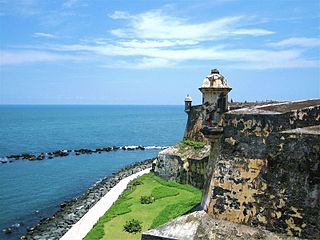
The invasion of Cuba took place between 4–5 August and 9 December 1741 during the War of Jenkins' Ear. A combined army and naval force under the command of Admiral Edward Vernon and Major-General Thomas Wentworth arrived off Cuba and fortified positions around their landing site at Cumberland Bay. Despite facing no serious opposition, neither commander felt prepared to advance on the Spanish settlement at Santiago de Cuba. Harassed by Spanish raids and with a mounting sick list, the British finally evacuated the island after several months of inactivity.

The Battle of Pinos was a naval engagement between a Spanish fleet under Admiral Bernardino Delgadillo y Avellaneda and the surviving ships of Francis Drake's expedition to the Spanish West Indies, now in command of Drake's lieutenant, Sir Thomas Baskerville, which took place off the Island of Pinos during the Anglo-Spanish war of 1585. The Spanish squadron was victorious, capturing two English ships.

Francisco Díaz Pimienta (1594–1652) was a Spanish naval officer who became Captain general of the Ocean Fleet.

Drake's Assault on Panama also known as the Defence of Panama was a military event that took place in January 1596 during the Anglo–Spanish War. An English expedition under the command of Francis Drake and Thomas Baskerville attacked the Spanish Main via Nombre de Dios in order to cross the isthmus of Panama. Ravaged with dysentery and other diseases the English were repelled and defeated. Drake would die of the former and the expedition was forced to retreat back to England all the while harassed by the Spanish.

Bastimentos was an island, anchorage and harbour near Portobelo on the north-western coast of Panama discovered and named in Spanish "Isle and port of Provisions" by Christopher Columbus in 1502 during his fourth and last voyage. Although the location of the two adjacent Bastimentos Islands is largely undisputed, the location of the harbour, shown on several 18th century Spanish maps as on the mainland opposite the islands, is suggested by various modern commentators to lie about 7 miles distant, thus its exact location is now uncertain and a matter of conjecture. Harris (2013) states: "by 1513 the record of (Columbus's) discoveries in this small region had become so clouded that it has since generated countless investigations and over the years a voluminous literature has been created in which attempted reconstructions of the voyage often have been conjectural and controversial". Bastimentos was the place where in 1726/7 the British Admiral Francis Hosier with three thousand of his sailors died of tropical disease whilst anchored with his fleet of 20 ships during the disastrous Blockade of Porto Bello. Due to the popularity of Richard Glover's poem and song Admiral Hosier's Ghost (c.1739), which mentions them twice, the Bastimentos became in England synonymous with "foul dishonour" and "shameful doom". The location should not be confused with Bastimentos Island, Bocas del Toro, 270 km to the west, also discovered by Columbus on his 4th Voyage, before reaching Portobelo.
Rear-Admiral Polycarpus Taylor was a Royal Navy officer of the eighteenth century, most notable for his service commanding ships in the West Indies during the War of the Austrian Succession. Having joined the Royal Navy some time before 1733, Taylor then served at the Battle of Cartagena de Indias and Invasion of Cuba before being promoted to commander in 1742. After commanding several vessels and being promoted to post-captain, in August 1744 Taylor took command of HMS Fowey; serving in the English Channel he ran ashore and destroyed the French privateer Griffon in 1745.

